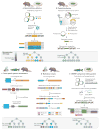Building a lineage from single cells: genetic techniques for cell lineage tracking
- PMID: 28111472
- PMCID: PMC5459401
- DOI: 10.1038/nrg.2016.159
Building a lineage from single cells: genetic techniques for cell lineage tracking
Abstract
Resolving lineage relationships between cells in an organism is a fundamental interest of developmental biology. Furthermore, investigating lineage can drive understanding of pathological states, including cancer, as well as understanding of developmental pathways that are amenable to manipulation by directed differentiation. Although lineage tracking through the injection of retroviral libraries has long been the state of the art, a recent explosion of methodological advances in exogenous labelling and single-cell sequencing have enabled lineage tracking at larger scales, in more detail, and in a wider range of species than was previously considered possible. In this Review, we discuss these techniques for cell lineage tracking, with attention both to those that trace lineage forwards from experimental labelling, and those that trace backwards across the life history of an organism.
Conflict of interest statement
The authors declare no competing interests.
Figures




References
-
- Sulston JE, Schierenberg E, White JG, Thomson JN. The embryonic cell lineage of the nematode Caenorhabditis elegans. Dev Biol. 1983;100:64–119. - PubMed
-
- Kelly SJ. Studies of the developmental potential of 4- and 8-cell stage mouse blastomeres. J Exp Zool. 1977;200:365–376. - PubMed
-
- Le Douarin NM, Teillet MA. The migration of neural crest cells to the wall of the digestive tract in avian embryo. J Embryol Exp Morphol. 1973;30:31–48. - PubMed
Publication types
MeSH terms
Grants and funding
LinkOut - more resources
Full Text Sources
Other Literature Sources
Molecular Biology Databases

